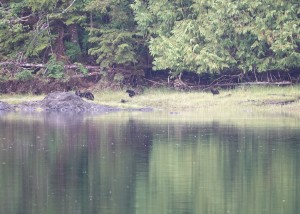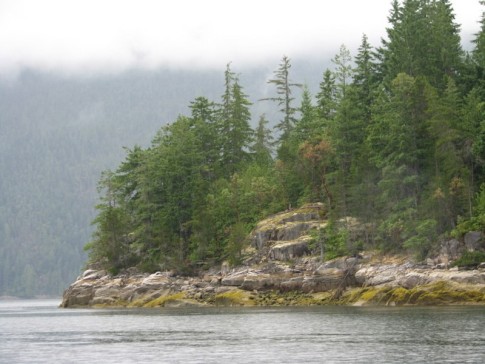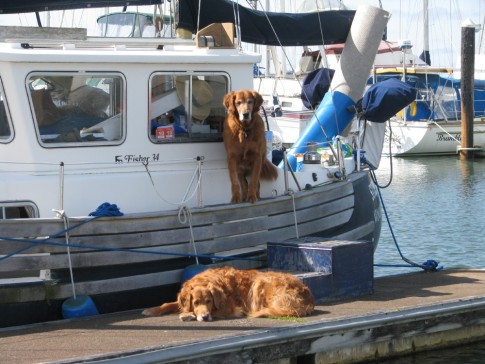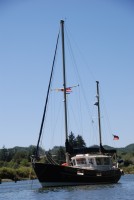Sirius Sailin'
| Vessel Name: | Storm Petrel |
| Vessel Make/Model: | Fisher 34 |
| Hailing Port: | Winchester Bay, Oregon |
| Crew: | Fraser and Jeff |
| About: | Additional Crew: Zac and Indy |
| Extra: | Storm Petrel is a 1977 Pilothouse ketch. She has sailed the Oregon/Washington coast since 1999, now home port is Pleasant Harbor, WA. |
30 September 2023
uly 24 - 25 A Rollicking Ride Down Hecate Strait to Cumshewa Inlet & Gordon Cove (53° 02.5’N, 132° 01.6’W) First Quarter Moon
The early morning was gorgeous! We got underway at 05:35 under thin, broken overcast skies with very light wind. The "Sleeping Beauty," a profile of a supine female form seen in the configuration of the mountain tops to the NW appeared navy blue in the early morning light. The gauzy white overcast was [...]
30 September 2023
July 23– Daajing Giids, Bearskin Bay, Queen Charlotte Harbor (53° 15.1’N, 132° 4.7’W) Waxing Cresent Moon
We left the marina by midafternoon with the intention of repositioning to the fuel dock adjacent to the marina in time to meet the attendant’s hours, 16:00-20:00 to this time of year. Before casting off the lines, we realized that the external regulator was not powered. Jeff did some troubleshooting [...]
30 September 2023
uly 21 – 22 Daajing Giids, Queen Charlotte Harbor (53° 15.2’N, 132° 4.4’W)
Although Jeff and I prefer to anchor out, being at a marina has advantages. It is easier to walk Zac and Indy at any time, engage in boat repairs and maintenance, explore the surrounding area, and of course, it is always nice to have a hot shower with plentiful water, that is, if one has enough “Loonies” [...]
Bunsby Islands to Kyuquot, Vancouver Island, BC
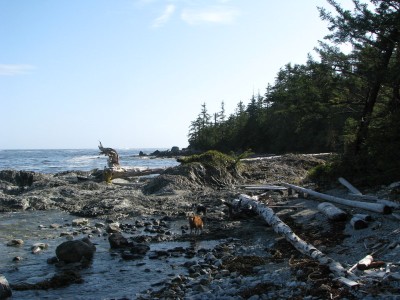
The Bunsby Islands are a uniquely beautiful, rugged, and remote group of islands that are well protected from the ravages of the open ocean winds and waves by an extensive system of reefs, islets and islands. Our chart refers to them collectively as the Barrier Islands. The Bunsbys, situated southeast of Brooks Peninsula are protected from the worst of the northwest storms. Storms from the southeast and south can more easily batter the islands save for the barricade of reefs and islands. One of the more enchanting aspects of the Bunsbys is the large population of sea otters that make them their home. We were thrilled to see the "little men with white whiskers and big noses" floating on their backs and using rocks to crack open clamshells against their bellies. Sea otters were successfully reintroduced to the West Coast in 1969 and 1972. A Dreamspeaker Cruising Guide (Vo. 6): The West Coast of Vancouver Island notes that "89 sea otters were relocated from Alaska to the nearby Checleset Bay Ecological Reserve" during that time period. Today there are estimated to be 2,700.
With a mind toward the strong southeast winds in the forecast, we anchored in "Scow Bay," a cove on Big Bunsby Island, well protected from that direction. We employed a stern tie around a tree on a small peninsula at the head of the cove along with our 35 pound Delta anchor to hold our position securely. Our anchorage afforded us a beautiful view of Vancouver Island's mountains to the northwest while we were surrounded by low, tree covered islands from all other directions.
On our second day, we all boarded our little dinghy for a trip to explore some of the other islands in the group. We wound our way down toward the end of Gay Channel and even though we were facing the open ocean, we only felt a slight swell due to the blocking effects of the barrier reefs and islands. We beached the dinghy and went exploring on foot along the south/southeast shore of the outermost island. We were impressed by the huge logs that were piled up above the normal high tide zone, flung there by aggressive winter storms. Of course along with the logs, there is a collection of flotsam and jetsam around, under, and on top of everything else there. In an earlier time, fishing nets were held in the top of the water column by glass floats attached to manila netting. Now, of course, those glass balls have been replaced by plastic and Styrofoam floats which litter the beaches well into the trees and shrubs surrounding the shoreline. They are not quite so fun to find as the glass floats once were. We have met folks who have been lucky enough to find an old glass float, but we are not able count ourselves among that group to date.
The Bunsby Islands are beautiful. Their remote and rugged nature provides a little bit of a buffer from humankind, where sea otters can gobble up sea urchins and abalone while watched by bald eagles and osprey. During the second afternoon that we were in the islands, we were on deck and heard an entire pack of wolves set up a chorus of howls from the island next door. It was enchanting and chilling at the same time. We realized that the exploration along the outer islands sans leashes was maybe a bit risky. Our lovely little border collie, Kaela, would make a tasty hors d'oeuvre. Casey and Jake might be a little stringy, but tasty none the less. We were quickly reminded of our proximity to the wilds of nature.
While we were snug in our little anchorage, the predicted storm swept by with winds of 30 to 40 knots bringing us a little bit of rain. We were glad to be tucked into a secure and protected place as we heard the wind and waves crashing on the outer islands. The winds we felt were light and only served to ripple the surface of the water around us. A tiny bit of swell entered the cove but never enough to notice once inside Storm petrel's salon.
On our fourth afternoon a pair of blue herons finally decided we were not too dangerous and landed in the trees behind us to preen. Then one heron landed very near us, on the rocks to fish. It was fascinating to watch as he/she moved so smoothly and stealthily to sneak up on a swimming morsel. We were surprised when the heron suddenly took to wing and dove into the water about 20 feet from shore. He quickly swallowed his prey then sedately swam back to the rocks. We watched while he performed this method of fishing several more times. Neither of us had seen a heron swim like a gull or duck.
As with most of the coves we've anchored in, there were at least one or two harbor seals that would cruise through enjoying the accumulation of herring seeking refuge in the inner bays. The sounds of fish jumping and splashing have become quite common place during the quiet evenings and nights. Unfortunately, Jeff's herring jig got so old that it deteriorated away and all the hooks broke off. He was a bit frustrated trying to catch a herring and never being able to get them to the boat. He's been yearning to try herring wrapped in bacon and grilled over the coals of the barbeque but will have to wait until he can replace his jig setup.
On the canine side, Casey finally got his stitches out! He was never so happy as to be taken off the restricted activity list! His ear healed up just like it was supposed to and there don't appear to be any complications whatsoever. On the very next day, Jake started limping on one of his front paws. On examination we learned that he had abraded the side of the pad on one of his toes. He's never one to complain much, so we didn't find this until it was getting rather ugly. We soaked it for 20 minutes for three days, cleaned it with hydrogen peroxide, applied antiseptic ointment and started him on antibiotics. Now, the swelling has gone away, the redness has decreased, he's not limping and it is beginning to heal. It is really difficult to keep his feet clean and dry when he has to wade through the water every time he gets shore leave. All three dogs have "Ruff Wear" shoes. They have Vibram soles and look a lot like water shoes we might wear while beachcombing. Now, whenever Jake goes to shore, we put his shoes on first.
The next afternoon we tried to find a spot to land the dinghy that would give Jake an easy and dry step to shore. Although we scanned the islet selected for the dog's outing before landing the dinghy, we missed a critical feature of the underwater geography; a barely submerged outcropping of dark, hungry rock. The dinghy just barely bumped the razor sharp, ugly rock and "whoosh, bubble, glug, glug. . ." happened. When you're in a small inflatable boat, thirty yards from the bigger, warmer, drier boat and the water temperature feels like there's no such thing as global warming, the sudden sound of whoosh, bubble, glug, glug is not a good thing to hear! The five of us leaped out of the rapidly deflating dinghy and onto the offensive rock in one movement.
The dinghy is constructed with three air chambers so it was not going to sink. We got everything out of the boat including the little outboard motor and carefully carried the limp dinghy onto the shore. We make a practice of always carrying our "dinghy bag" with us. One of the bag's "must have" items is a cool little plastic clamp that slips into the tear and clamps from both the inside and outside of a hole. This little gadget allowed us to pump up the damaged air tube and get all of us back to Storm Petrel without getting wet.
Our repair kit has patch material, glue and instructions for just such an occurrence. Of course, the patches included are for small punctures and not sufficient for three-inch slashes in the side of the tube. We hunted and searched for patch material and finally came up with the bag we store the dinghy in when it's deflated. The bag is the same material albeit a little bit lighter, but it made a good patch. We cut out a piece of the bag three inches by eight inches to provide plenty of overlap and using the entire tiny tube of glue, we went about repairing the dinghy.
On a cruising boat, a dinghy is not just a nice-to-have item. A dinghy is a necessity, especially when you have three dogs aboard that really prefer to relieve themselves while standing on terra firma. The dinghy serves as our little economy car. It transports us to and from our floating home, so when we have a leak in our dinghy, it is a major concern. The dinghy carries groceries and water, takes us fishing, exploring, and to the various dog islands. The instructions for patching the leak mentioned things like 15 to 18 degrees centigrade, controlled humidity, and 72 hours, so it was with our fingers crossed that we pumped up the afflicted tube the next day. Well, we had good news and bad news: the dinghy held air, just not all at once. It still had a slow leak but appeared to be temporarily manageable. We were able to get the dogs ashore as needed, keeping the pump handy, but something more permanent was required before we could continue cruising comfortably.
We left the Bunsbys on the morning of the 29th of August en route to Walter's Cove, Kyuquot, BC. There are two courses that can be taken from the Bunsbys in Checleset Bay to Kyuquot on the northwest corner of Kyuquot Sound: one outside all the reefs and islets and the other, along the shore of Vancouver Island. We chose the inside route since there were still some large waves from the recent storms. We enjoyed the impressive scenery of the rugged shoreline and protecting reefs and shoals, however, the proximity to some of the rocks and reefs with waves splashing over them was hair-raising at times. With Fraser and Jeff both busy studying the route ahead for submerged rocks and shoals, Casey started barking. We both looked over to see two humpback whales alongside us going in the opposite direction. Unfortunately with the choppy conditions and proximity of hazards, we could not stop to watch the whale and had to continue forward.
We arrived at the public dock at Kyuquot (pronounced: ki-YU-kit) after weaving our way around the hazards, channel markers and light boat traffic into the quiet, picturesque little harbor. The Kyuquot Market is at the head of the dock. It offers fresh items and a good selection of staples. There are several lodges that cater to the sport fishing and kayaking crowd, but no pubs or restaurants. Across the harbor from the little community is the First Nation community of Kyuquot. Between the two communities on either side of the harbor there is a permanent population of about 200 people. There are no roads accessing the area, so everything comes in by air or by boat. The mail plane arrives every Monday, Wednesday, and Friday and every Thursday the main supply ship, the Uchuck III comes in to the public dock. The Uchuck III is a converted WWII wooden minesweeper. She brings in everything that won't fit on a floatplane and a few passengers as well. She will stop to drop off or pick up kayakers anywhere along the way from Gold River where she is home ported.
At Kyuquot we were able to top off our water tanks and restock our grocery needs, including a large bag of dog food. The store is not large, but has an amazing variety of supplies. There is also a dumpster to collect trash, something hard thing to find on the west coast. There is no set fee for water, moorage, or garbage but they do accept donations to help pay for the garbage pick-up. One of the nearby lodges had just finished their season and allowed us to buy showers and the use of laundry facilities for a load of wash.
The day after we arrived in Kyuquot, the sun shone brightly and the wind couldn't find us at all through the trees and islands that ring the harbor. It was a perfect day for dinghy repairs. We rigged a shade to prevent the glue from curing too quickly in direct sunlight. We cleaned the area around the original patch then stripped any possible oil with alcohol. We roughed the surface to help the adhesive bond to the patch and dinghy. We finally decided that the thing to do would be to add a larger patch over the first one after we resealed the original where it was seeping. We spent the morning affixing the new patch as best as could be accomplished under the conditions we had. It looked pretty good until we inflated the boat the next afternoon. There was still air seeping out from a couple of spots. The rip was just too big to be repaired without professional help. We read up on the process on the internet and found that all recommendations for our size hole are to have the repair made by a professional facility with controlled conditions and the ability to apply a patch to the inside as well as the outside.
The search for a replacement dinghy intensified and we started seriously canvassing the harbor residents for a used boat to buy. Of course, that kind of thing is just not readily available in a community that relies on its boats. There really aren't any spares. We ended up ordering a new dinghy, albeit a little smaller, from West Marine in Nanaimo. Rebecca from West Marine was invaluable in finding someone to deliver the new dinghy to the Uchuck III in Gold River and arranging for the dinghy to come to us in Kyuquot. With our order placed and nothing else to accomplish, we left Kyuquot with our leaky dinghy and a pump to explore the islands of the sound.
1 September 2009
When we left Walter's Cove/Kyuquot a light wind was blowing and there were blue skies overhead. We picked our way through the numerous rocks and shoals to enter Kyuquot Sound. Dixie Cove, Hohoae Island was our destination. Almost to Dixie Cove, we were hailed on the VHF radio by a group of kayakers clustered under the overhanging trees along the north shore of Pinnance Channel. They reported missing two members of their party and wondered if we could see them from our vantage point. The "lost" paddlers were quite a distance from the group when we first spotted them through the binoculars. They were paddling rapidly in the opposite direction at about our rate of speed. It was our intention to ask if they needed assistance but we never did catch-up to them. Instead we visually followed their yellow canoe until it entered Fair Harbour, homeport for the group. After hailing the group leader on the VHF radio to report our sighting, we headed back toward Dixie Cove.
The entrance to Dixie Cove is a narrow cleft between Hohoae and smaller Copp Island. The inner harbor is very well protected and isolated from any wind or waves that might be kicking up. We anchored in the middle of the quiet cove and immediately took the dogs to the nearest spot of land with decent access (rocks not too sharp!). The patched dinghy held air in the tube for the trip, which gave us confidence to go a bit farther from Storm Petrel on the next outing.
The following morning we explored the little spit of land that serves as a wind block at the entrance to the inner cove. The dogs had a wonderful time charging around the little peninsula, racing between trees, and diving off rocks. We got tired just watching the high-pace activities. They swam until they were tired enough to fully relax back on the boat. Jeff picked a few blue huckleberries and salal berries to add to the evening's fruit crisp desert. We had a great dinner of barbecued chicken (from the pressure cooker), blue cheese/garlic mashed potatoes and sautéed peas. We enjoyed another peaceful night, unaware of the weather outside.
3 September 2009
We left Dixie Cove around noon to head back to the public dock at Kyuquot to meet the Uchuck III with our new dinghy in its hold. The trip should have been an easy two-hour sail, but the strength of the winds and seas coming up the channels among the islands was surprisingly strong. Initially we were able to pull out the jib and have a relaxing sail. We were enjoying the pleasant hiss of water passing by the hull as we sailed at up to five knots under jib alone. Then, we sailed behind Union Island and into the wind shadow it created. We rolled up the jib and fired up the "iron jenny" to motor into Crowther Channel through the narrow neck abeam Surprise Island. The wind was now funneling down the channel towards us and reaching speeds of at least 30 knots. Our speed dropped from 5.3 knots to 4.3 knots just from the head wind. The increased wind and choppy seas created quite a challenge as we weaved our way back through the hidden rocks and shoals. We retraced our outbound course and were relieved to find that Walter's Cove was completely calm, although rainy. We had an unexpectedly easy time tying-up to the Kyuquot public dock.
The Uchuck III was already alongside the dock and unloading her cargo when we arrived. Once Storm Petrel was secured, we headed up to the Uchuck III to claim our new dinghy. Fraser met the captain and in the process of paying the slight charge to transport the dinghy, was invited to see the pilothouse. The bridge was beautifully paneled and had a classic, spoked wooden ship's wheel. As we waited for the dinghy to be lifted from the hold, we were interested to see a man sitting in his kayak being lifted from the water onto the ship's deck. We can only imagine what sea conditions he experienced as he navigated through the storm.
4 September 2009
The tempest raged all night off the coast, but Storm Petrel rested quietly alongside the public dock in Kyuquot. We did experience rain and though we could hear the wind roaring through the trees surrounding the harbor and the waves crashing on the outer side of the protecting islands, we felt none of it. Environment Canada issued a Storm Warning during this time period. Such a warning indicated that wind speeds of 48 to 63 knots were in the forecast for the north coast.
Having the internet available is a huge advantage in looking at the weather forecasts. The Environment Canada folks never used to provide long range information in their VHF weather forecasts, but this summer they began to provide a rough forecast out to five days. On the internet we're able to see the latest guesses out to ten days and that gives us a better feel for the trends. The weather does not look good for the next few days in terms of leaving Kyuquot Sound for Esperanza Inlet and Nootka Sound.
Our next hurtle as we sail down the west coast of Vancouver Island is Estevan Point, a narrow point extending eight miles into the Pacific from the main body of Vancouver Island. Rounding Estevan Point is not typically considered to be the major challenge that Capes Scott and Cook are to mariners but in unsettled weather all of the coast can test seamanship. Estevan Point is generally considered to be the dividing line between West Coast Vancouver Island North and South, as far as weather forecasts are concerned. Generally, forecasts for the southern portion of Vancouver Island call for relatively calmer conditions. The weather northwest of Estevan Point, in our observations, often seems to include higher winds and sea states.
Hanging out in Kyuquot is a pleasure. This morning we arose to watch two otters playing in the harbor not far from Storm Petrel. They were enchanting to observe as they rolled in unison, hugging each other, and patting one another's heads. At one point the two otters popped halfway out of the water locked together in an embrace. They looked like they were having a wonderful time. It is always a pleasure to see them and to watch their antics. This was the first time we've seen two of them playing with such abandon. Usually they are munching away on clams or items that otters find delectable.
We will wait for the Kyuquot Market to open this afternoon to stock up on a few things we've used over the past several days, but don't expect to be able to leave Kyuquot Sound until early next week. We hope to explore this area more thoroughly in the meantime. There is a beach at Rugged Point that is reportedly the prettiest beach on the West Coast of Vancouver Island. Not far from the beach is a protected cove with pictographs on some of the rocks where we hope to spend a couple of days. It is often a challenge to judge weather conditions off the coast from the comfort of a protected cove. We've found that many of the anchorages we enjoy do not have decent coverage of VHF radio weather broadcasts so we have to leave the cove, ready to go to sea, to check the weather forecast. We hope to send the next blog from Nootka Sound or Clayoquot Sound.
